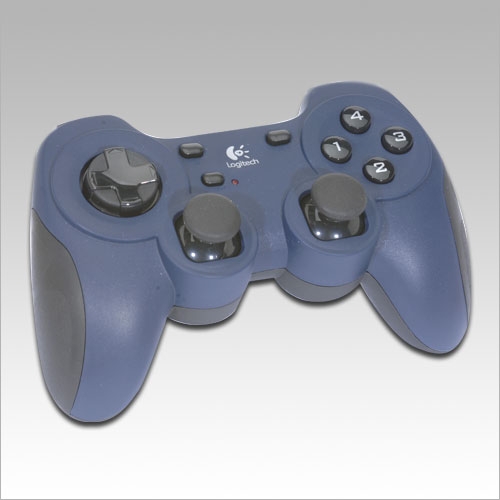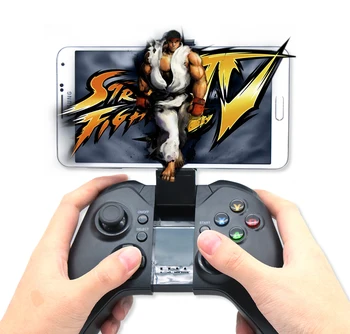Twin Usb Joystick Driver


The USBJoystick interface is used to emulate a joystick (gamecontroller) over the USB port. You can send throttle, rudder, and X, Y co-ordinates as well as button and hatswitch states. Wiring You can use an existing USB data cable and cut off one end. This typically exposes four wires, Red, Black, White and Green. On the mbed LPC1768 the USB connector should be attached as follows: • Green USB D+ to p31 • White USB D- to p32 • Red USB 5V to Vin • Black USB GND to GND You can connect the USB power to VIN to power the mbed board from the Host PC when connected. Identify the correct D+ and D- pins on other mbed boards, the ST Nucleo F411RE for example uses these pins: • Green USB D+ to PA_12 • White USB D- to PA_11 • Red USB 5V to E5V (with jumper JP5 set to E5V) • Black USB GND to GND • Note that a 1k5 pullup resistor is needed between the 3v3 pin and the D+ pin or the host PC (Windows) will not recognise your board as a USB device.
• Note that on some boards the pullup is actually switched on or off by another processor pin. That allows enabling or disabling the USB communication under software control. Indesign Cs3 Download Portable more. Here is an example schematic from the mbed LPC1768 USB section. In this case the pullup is switched by T2 which is controlled by the LPC1768 chip.
Download the latest drivers for your USB Vibration Gamepad to keep your Computer up-to-date. Hello everbody, ive made the horrid mistake of buying a twin usb PS2 controller off Ebay. By twin usb i mean that there are two ps2-like controllers that.
The Nucleo doesnt have the pullup by default. Check the hardware schematic of your (non-)mbed boards and modify accordingly. • Note that the filtering networks 33R/18pF on D+/D- are recommended, but sometimes not present on a board. SystemCoreClock and USB clock • Note that the USB hardware engine needs an accurate internal clock of 48 MHz. Some (non-mbed) boards may default to a not so accurate internal oscillator that is not stable enough for reliable USB communications • Note that the Nucleo's need a specific USB device lib to work with the Joystick lib that is presented here. The reference at the end of this page should help you get started. Some other ST F103 examples are and.
Hello World USBJoystick Hello World. Windows Driver Troubleshooting! Note that changing the descriptor also requires a new Vendor ID and/or Product ID (see Joystick constructor).
That is needed because Windows links the VID/PID to a specific descriptor so that it knows which device driver should be loaded. When you change the descriptor and windows detects a mistake (eg missing or wrong bit padding) it will fail to install the USB HID driver and you probably need to use another Product ID to retry after fixing your code.
Adobe Acrobat Xi Pro Crack Mac Italk. Once you have modified the descriptor, you obviously also need to modify the update method to fill the correct bits in the report message structure and set the correct report length. Wrote: I was planning to use port this code to create an arcade stick controller. But I'm not a mbed expert.
I have imported the project and the library. But i didn't found any axis or buttons on the USB descriptor. Can you give me a little help? Where do I define whitch pins to use. Take the example code shown above, add some DigitalIn pins to read your buttons and AnalogIn pins for analog values like the throttle. You then need to use these input values to set the bits in the variables for 'button' or to set the value of 'throttle'. So your own values replace the dummy value 'i' that is currently used for testing.
You can read up on DigitalIn in the handbook and on AnalogIn. Obviously you need to connect external switches and potmeters to generate the inputs for the software to work. >I was planning to use port this code to create an arcade stick controller. But I'm not a mbed expert. I have imported the project and the library.
But i didn't found any axis or buttons on the USB descriptor. Can you give me a little help? Where do I define whitch pins to use. >Take the example code shown above, add some DigitalIn pins to read your buttons and AnalogIn pins for analog values like the throttle. You then need to use these input values to set the bits in the variables for 'button' or to set the value of 'throttle'.
So your own values replace the dummy value 'i' that is currently used for testing. You can read up on DigitalIn in the handbook [[ here]] and on AnalogIn [[ here]]. Obviously you need to connect external switches and potmeters to generate the inputs for the software to work. Wrote: I was planning to use port this code to create an arcade stick controller.
But I'm not a mbed expert. I have imported the project and the library.
But i didn't found any axis or buttons on the USB descriptor. Can you give me a little help?
Where do I define whitch pins to use. Take the example code shown above, add some DigitalIn pins to read your buttons and AnalogIn pins for analog values like the throttle. You then need to use these input values to set the bits in the variables for 'button' or to set the value of 'throttle'. So your own values replace the dummy value 'i' that is currently used for testing. You can read up on DigitalIn in the handbook and on AnalogIn. Obviously you need to connect external switches and potmeters to generate the inputs for the software to work.
Yes I've found it. I've managed to change the activation of the 4 buttons. But I couldn't increase the number of buttons I've changed the define '#define REPORT_ID_JOYSTICK 16' I saw this command ' report.data[4] = ((_button & 0x0f) >>I was planning to use port this code to create an arcade stick controller.
But I'm not a mbed expert. I have imported the project and the library. But i didn't found any axis or buttons on the USB descriptor. Can you give me a little help? Where do I define whitch pins to use.
>Take the example code shown above, add some DigitalIn pins to read your buttons and AnalogIn pins for analog values like the throttle. You then need to use these input values to set the bits in the variables for 'button' or to set the value of 'throttle'.
So your own values replace the dummy value 'i' that is currently used for testing. You can read up on DigitalIn in the handbook [[ here]] and on AnalogIn [[ here]]. Obviously you need to connect external switches and potmeters to generate the inputs for the software to work..
@mark The buttons are all independent. They take up one bit per button in the report.data[] bytes. In the testcode I just emulated most buttons. I think I used a simple counter and copied or inverted and copied the countervalue into the report.data[] fields. That's why you see the same values in the 2nd and 3rd row while the 1st and 4th are inverted patterns.
In a real joystick you would readout DigitalIn pins, possibly declared as a BusIn. You could also use a simple I2C or SPI port expander (eg PCF8574) to save on DigitalIn pins. That should still be fast enough. You may also want to add some software or hardware debouncing on the pins. Pullup or Pulldown would both work.
I prefer pullup resistors and a switch that closes the circuit to GND. This Joystick example is quite old. I will have a look at the latest release of the USBDevice lib and mbed lib to see where the warnings or errors come from. The F411 and other ST devices need an adapted USBDevice library as it does not yet support the ST devices. This will get you started. @mark The buttons are all independent.
They take up one bit per button in the report.data[] bytes. In the testcode I just emulated most buttons. I think I used a simple counter and copied or inverted and copied the countervalue into the report.data[] fields. That's why you see the same values in the 2nd and 3rd row while the 1st and 4th are inverted patterns. In a real joystick you would readout DigitalIn pins, possibly declared as a BusIn. You could also use a simple I2C or SPI port expander (eg PCF8574) to save on DigitalIn pins.
That should still be fast enough. You may also want to add some software or hardware debouncing on the pins. Pullup or Pulldown would both work.
I prefer pullup resistors and a switch that closes the circuit to GND. This Joystick example is quite old. I will have a look at the latest release of the USBDevice lib and mbed lib to see where the warnings or errors come from. The F411 and other ST devices need an adapted USBDevice library as it does not yet support the ST devices. This [[ link]] will get you started.
I have mostly finished a fork of this program and changed it to 6 axes. I'm using it with the FRDM-KL25Z and get the joystick showing up properly in Windows 10 with the right number of controls, but nothing moves when I change the analog inputs. The buttons don't even cycle as they did before (same code). I have updated the product_id in the joystick constructor so it is installed fresh, but still no movement. Any ideas as to what's wrong? My code is here: >Thanks!
OK, so according to your descriptor you are using 16 bit values for each of the 6 Axes. That means 2 bytes must be used for each axis in the report.data record. The update method should set these 2 bytes to prepare the new report message. However you set only one byte per axis and consequently the report length does not match the descriptor. The windows HID driver doesnt like that incorrect message format and ignores it all (no change in buttons etc): Your code: >// Fill the report according to the Joystick Descriptor report.data[0] = _x & 0xffff; // note that _x is 16 bit, but report data is 8 bit! Report.data[1] = _y & 0xffff; report.data[2] = _z & 0xffff; report.data[3] = _rx & 0xffff; report.data[4] = _ry & 0xffff; report.data[5] = _rz & 0xffff; // report.length will be wrong. >Should be: >// Fill the report according to the Joystick Descriptor report.data[0] = _x & 0xff; report.data[1] = (_x >>8) & 0xff; report.data[2] = _y & 0xff; report.data[3] = (_y >>8) & 0xff; etc.
>I have tested X,Y plus 6 axes (with 8 bit per axis) and that works. Note that the 'HID DEVICE properties' dialog window only seems to show X,Y plus a maximum of 6 more axes. When you add more channels some will no longer show up although updating continued.